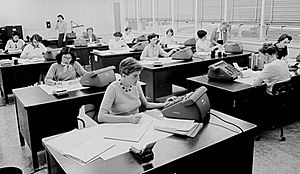Barbara Canright facts for kids
Quick facts for kids
Barbara Canright
|
|
|---|---|
| Born |
Barbara Canright
November 12, 1919 Ohio
|
| Died | September 17, 1997 Seattle, Washington
|
| Nationality | American |
| Occupation | JPL Human Computer |
| Employer | Jet Propulsion Laboratory |
| Spouse(s) | Richard Canright (1938-1964) |
| Children | Bruce Canright
Patricia Canright Smith Geoff Canright David Canright |
Barbara Canright (born St. John, 1919 – 1997) was an American human computer at NASA's Jet Propulsion Laboratory (JPL). She was the very first female mathematician hired there. Barbara joined JPL in 1939. A "human computer" was a person who did many long and difficult math problems by hand. This work was often split among teams to get it done faster.
During her time at JPL, Barbara was key in figuring out how well rocket engines would perform. She calculated the "thrust-to-weight ratio," which helps engineers understand a rocket's power. She also helped determine the best rocket fuel, which was later used by the U.S. Navy. Barbara Canright's work was very important for the early JPL program. She also helped open doors for other women to work in science and engineering, a field that had been mostly for men before.
Contents
Barbara Canright's Early Life and Education
Barbara Canright was born on November 12, 1919, in Iowa. This was during a lively time in America called the Roaring Twenties. Barbara was a very bright student in high school. She took advanced classes, especially in math and chemistry.
She met her future husband, Richard Canright, at Miami University of Ohio. Her father was a professor and dean at that university. Barbara and Richard got married when she was 19 and he was 21. They moved to Pasadena, California, so Richard could go to graduate school at Caltech. Before working at JPL, Barbara was a typist. She also went to Occidental College in Los Angeles. She graduated from Occidental College in 1940.
Her Amazing Career at JPL

In 1939, the National Academy of Sciences gave a grant of $1,000 for rocket research. This grant went to Caltech's Guggenheim Aeronautical Laboratory. This group was sometimes called the "Suicide Squad" because some of their early experiments went wrong. The next year, the U.S. government invested $10,000 more into the program. This extra money allowed the group to hire more people.
One of the men who started JPL, Frank Malina, asked Barbara and Richard Canright to join as mathematicians. Both Barbara and Richard accepted the jobs. This made Barbara the only female employee at JPL at that time.
While at JPL, Barbara calculated the power from rocket engines. She also looked at the data to make the rockets work even better. One of JPL's biggest successes, thanks to Barbara's work, was using rockets for bomber aircraft. After successfully developing jet-powered bombers, JPL started focusing on designing a rocket that could fly higher than a helium balloon.
Barbara Canright, along with Melba Nead, Virginia Prettyman, and Macie Roberts, were in charge of figuring out the best rocket fuels. In 1943, after they successfully designed and tested a new rocket fuel, Barbara became pregnant with her first child. Back then, there was no maternity leave. Because of this, Barbara had to leave her job at JPL.
Later Life and Family
Barbara Canright's life after JPL is not as well-known. However, her daughter, Patricia Canright Smith, has shared some information. Barbara and Richard Canright had four children together: Bruce, Patricia, Geoff, and David.
- Bruce became a scientist at NASA.
- Geoff became a physics professor.
- David became a math professor.
- Patricia became a psychotherapist.
Barbara and Richard Canright divorced in 1964 after 26 years of marriage. Barbara Canright passed away in Seattle, Washington, on September 17, 1997. She was 78 years old.
How Barbara Canright is Remembered
Barbara Canright played a very important part in the early days of the JPL program. Her work has been recognized in several ways:
- Nathalia Holt's book Rise of the Rocket Girls tells her story.
- Occidental College, where Barbara studied, wrote an article about her called Guardians of the Galaxy.
- Barbara's daughter, Patricia Canright Smith, wrote a poem called She Would Love to See China to honor her mother's life.

